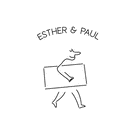Born in 1954 in Rabat, Youssef Amghar is a Franco-Moroccan artist who divides his creative time between the radiant light of northern Morocco in Moulay-Bousselham and the cloudy skies of the French Atlantic coast.
After studying architecture at the École des Beaux-Arts in Paris, Youssef Amghar studied literature at Paris XIII as well as photography courses at EFET. Artist, poet, novelist, Youssef Amghar is a complete artist but it is his poetry surrounded by blue that he expresses in his cyanotypes that won us over at Esther & Paul.
“Cyanotype, a photograph with an ancestral process, azure, as if to ward off the patina of time.
For me, cyanotype is like a return to the sources in every sense of the word. A return to the time when the image was subject to the random, the probable, almost to chance. An image is revealed by light, it is as if tamed, coaxed, desired and time and patience are its stimuli. An image is made and experienced like a journey, a journey between the lines, in an atmosphere, in the interstices of movement. Cyanotype allows me to live the time of the construction of an image, a time necessarily slow, necessarily uncertain, a time where the possible competes with the probable for its presence.
I dig on paper some of my encounters, a paper that I insolate myself as if to give a bed, a field, a construction site to my impressions, to my own presence in the world. I invite the light of day to come and fertilize this paper to reveal the image that is impregnated with it. It is an old kitchen, a kind of magic pot in which I dip my imagination as one dips one's pen in ink carefully refined by time.
